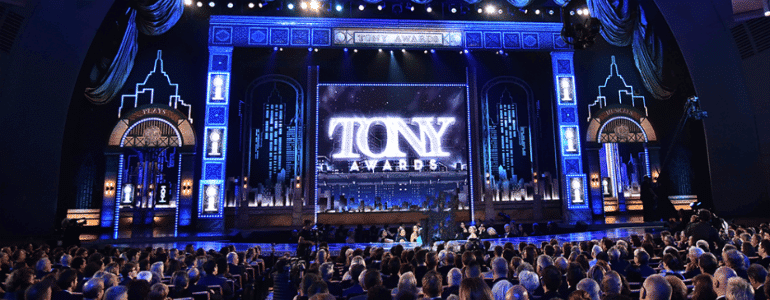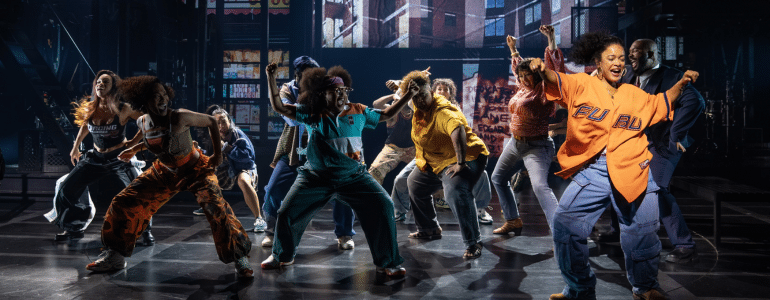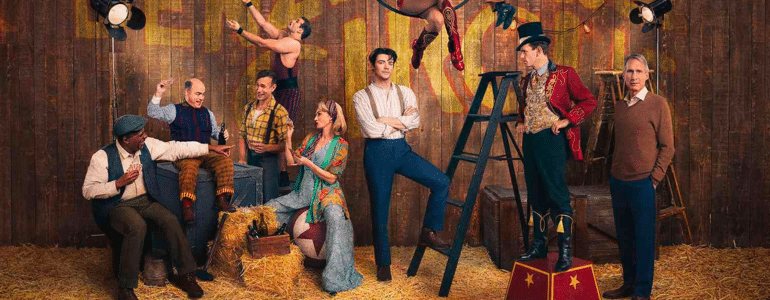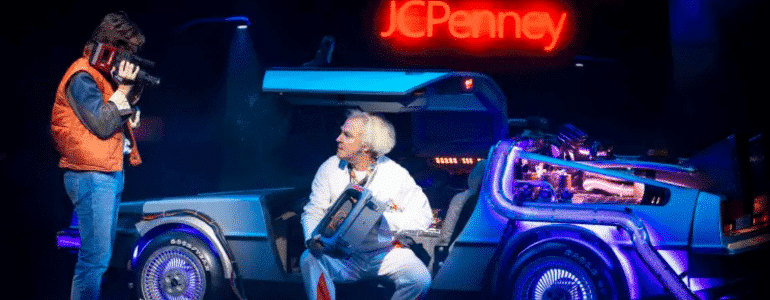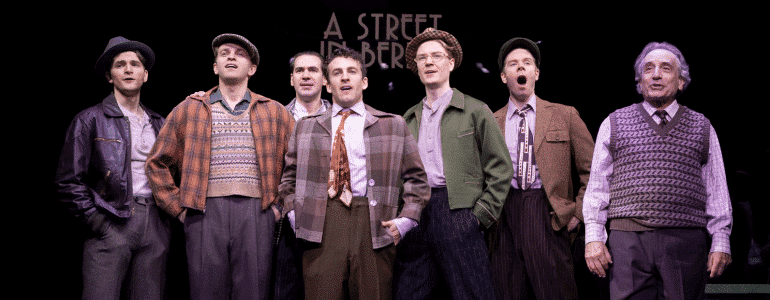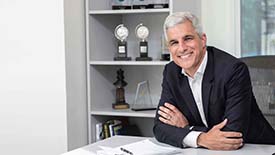Podcast Episode 46 Transcript – Susan Stroman
Ken: Hello, everybody. Welcome back to the Producer’s Perspective Podcast. I’m Ken Davenport and today . . . okay, look, I’m just going to say it. We’re talking to one of the most successful directors and choreographers in the business, both artistically and commercially. That’s right, people . . . I’m thrilled to be chatting here today with five-time . . . say it, five-time . . . Tony Award winner Susan Stroman. Welcome, Stro!
Susan: Thank you. Well, I’m happy to be here.
Ken: You can go on PlaybillVault.com to see all of her credits, but we’re talking big blockbusters like Crazy for You, Show Boat, The Producers, Young Frankenstein, The Scottsboro Boys, Big Fish, Bullets Over Broadway . . . just a few of the long list of credits of Stro’s. I’m not going to list them all, again, because it will take about 18 hours to get through them all, so we’ll just get to the good stuff. How did you get started in the theater? Where did it begin?
Susan: Oh my. I have to say I had been in a dancing school since I was about five years old, and my father was a wonderful piano player, so I was that little kid that would dance around the living room to her father playing the piano. I’ve always been in a dancing school, my whole life, and it’s because of my mother and father. They really admired music and felt it was important in one’s life, and it was really being completely passionate about music and about my father’s piano playing really, so I would start to create dances even at an early age because I would hear his music and begin to dance, so choreographing has been a very natural part of my life since I was a little girl.
Ken: Where was this? Where did you grow up?
Susan: I grew up in Wilmington, Delaware – I know – and I went to the University of Delaware, so I’m a Delaware gal through and through. Being in Delaware, that means you’re close to Philadelphia, of course, so I grew up doing community theater in the Delaware area and the Philadelphia area and, as much as I loved dance, I loved theater even more. I studied ballet and tap and jazz and, although I loved all three, it was dance and the theater and storytelling that I loved the most. So my trajectory, instead of taking me to choreograph for ballet companies or modern dance companies . . . I really wanted to go into the theater because it was all about storytelling.
Ken: Do you remember the first big show you saw? The first big Broadway show or touring show you saw?
Susan: I remember very clearly. There’s a wonderful, beautiful playhouse in Wilmington, Delaware at the Hotel du Pont and I would try to go there as much as possible, and it was a big deal to get down to downtown Wilmington. My parents didn’t want me to go downtown in Wilmington but one time, without their knowing, I went down and I got a front row ticket for a touring company of Seesaw, and I sat there and out came this tall drink of water called Tommy Tune, tap dancing in clogs, and girls and balloons and Gittel Mosca and a story about a girl in New York and I thought, “This is for me!” I really wanted to do this. It’s just was one of the shows that stuck with me.
Ken: How old were you then?
Susan: I would have been in the last year of high school, probably.
Ken: Apart from the dances you created in your living room to your dad’s piano playing, what was the first thing that you actually choreographed, the first show?
Susan: Well, let’s see, it would have been in community theater. I suppose it would have been maybe Applause. Applause in community theater.
Ken: Again, high school age, college age?
Susan: High school age.
Ken: So you were choreographing back then?
Susan: Yes, definitely. I even choreographed the halftime shows for the high school band. Yes, I was choreographing at a very young age and creating.
Ken: So how do you create? I think everyone out there knows a book writer for a musical sits down at a keyboard and types, a musician or a composer might sit down at a piano and play, but I think the choreographing process is probably the biggest mystery of them all.
Susan: Yes, I think so.
Ken: So what do you do?
Susan: Well, ever since I was little I would visualize music and still, to this day, I visualize music. When I hear it, whether it’s an old standard or rock ‘n’ roll or a classical piece, I imagine people dancing and a stage and costumes, the whole thing. So music isn’t really a relaxing element in my life because my brain starts to spin. And I think the first thing I do when I do a show is really listen to the music over and over and then a lot of it is arranging the music to enhance and support the choreography. That’s another thing . . . at a very young age I was inspired by watching Fred Astaire and Ginger Rogers movies. It was a big deal when they came on television. I could see how, when Fred Astaire would dance, the orchestra completely supported his movement, and I understood that at an early age too, how, if Fred Astaire jumped in the air, so did the orchestra. So arranging for the dance is also a big part of what I do when I create a new piece. I work with the composer and I work with the dance manager but it all is one and I’m very much a part of it. Even the time signature tells a story. For example, in Crazy for You, Bobby and Polly, if I want them to be coy and shy with each other they can play “Shall We Dance?” in a soft shoe rhythm. If I want them to fall in love, of course we play it in 3/4 time. If I want them to chase each other we do it in a fast two. So even time signature in a melody can help you tell a story and elicit emotion from the audience.
Ken: How much musical training do you have? It seems like a choreographer really has to understand it.
Susan: Well I think so. I think you really have to understand music. I took piano and guitar when I was little, but now it’s all about the dance for me and it comes quite naturally to work musically with people.
Ken: So you are at the University of Delaware, you’ve got this long list of halftime show credits and Applause at the community theater . . . how do you jump from there to New York City and start to work professionally? How did that happen?
Susan: I was sort of a big fish in a little pond there in that area, doing a lot of the shows in all the different community theaters, and at that time there were dinner theaters in that area. And one day I had a friend who said, “Let’s go to New York and audition for something called the Goodspeed Opera House,” and I just went along, not really knowing what I was getting into, and I walked in and there seemed to be 400 girls in this one room, which I couldn’t believe, and we were all auditioning for the Goodspeed Opera House for a show called Hit the Deck, and they were going to cast the whole thing that day and, out of all those girls, they picked two girls who were non-Equity, and one of those girls was me. All of a sudden I got a call saying, “This is when you start at the Goodspeed Opera House, and you’re getting an Equity card . . .” I didn’t really know what an Equity card was. I sold my car, told my parents goodbye and, all of a sudden, I was in the business. I’ll never forget the first day of rehearsal. One of the cast members named Hal Shane sat next to me and said, “So, how long have you been in the business?” and I said, “Five minutes!” So then that was it. I did Goodspeed and then started to audition and did the national tour of Chicago, I was the Hunyak. That was with Gwen Verdon and Chita Rivera and Jerry Orbach. I took acting lessons from Jerry Orbach while I was on the road. It was sort of a whirlwind when I got started. However, the whole time I was performing, I was thinking I needed to be on the other side of the table. Although I came to New York as a song and dance gal, because I could sing and dance, it wasn’t what I wanted. I wanted to create for the theater. I wanted to be a creator. So I started to choreograph and direct small things like industrial shows, club acts, commercials, anything I could to be on that side, and it made me very happy, happier than performing. I know in New York you can’t really have a split focus. You have to choose one thing and that’s it. If you have a split focus people don’t believe in you, if you want to do a million things, at least at that time. Maybe it’s different today. So I decided to not be seen any longer as a performer and just take my chances. I was performing in a show called Musical Chairs . . . it lasted maybe two weeks on Broadway . . . but another fellow was in that show with me, named Scott Ellis, and we were lamenting one day about how we wanted to be directors and choreographers and not be in a show. Scott had done The Rink with Kander and Ebb and I had done Chicago and we thought, “What if we ask them if we can take one of their shows and take it Off-Broadway?” and we decided we would ask them about Flora, The Red Menace and maybe we could do a small version of it, and the worst thing that could happen would be they could say no. So we got brave and asked them, and they said yes. We couldn’t believe it. They said yes, so then we had to find a place to do it so we went down to the Vineyard Theatre and pitched our idea of doing it in the form of WPA theater and they said yes, so all of a sudden we were doing this Kander and Ebb show Off-Broadway. We couldn’t believe it, it was wonderful. I think we made about $200 for the entire summer, but everyone saw it. It had a little bit of a cult following so that launched our careers. We became best friends with Kander and Ebb and still to this day . . . I just saw John Kander today. We have remained friends after all these years. We created And the World Goes ‘Round with them. and we did Steel Pier with them and then, of course, I went on to do The Scottsboro Boys with them And then Hal Prince saw it and I ended up doing Don Giovanni and Show Boat with Hal and today I’m doing Prince of Broadway with Hal, so he became a good friend. And Liza saw it and I ended up doing Liza’s big show at Radio City Music Hall. So taking a chance and knocking on Kander and Ebb’s door really launched our careers and I never went back on a stage.
Ken: Do you remember your work in Flora, The Red Menace? Back then, do you remember?
Susan: Yes, I do remember. I think I had a montage in there where Flora lived with all of these artists in a big loft and a montage came together about all of the things that they did as artists, and I think that’s the thing that Hal thought I would be good for with Show Boat because there are big montages in Show Boat. Yes, it was great, and I think Kander and Ebb really enjoyed working in a small venue also and having another shot at that show.
Ken: That montage you talk about . . . and, for those of you who don’t know, I was the associate company manager on that production of Show Boat, so I used to do Susan’s house seats all the time . . . that montage was such a brilliant passage of time in that piece, it was so wonderful. You have these iconic numbers . . . “Slap That Bass” in Crazy for You, the little old lady number in The Producers . . . so many iconic numbers, what’s your favorite? If the Smithsonian was putting one of your numbers into the Institute, which one of them would you want them to put in?
Susan: It is hard to pick. I try to . . . or not even try to, but I feel like, in every show, it’s wonderful if you can create an image for that show that goes with that show that an audience will remember, like the girl in the yellow dress or the walkers. There’s something in every show that you want people to remember, and something that they’ve never seen before. So I’m not sure. I think probably . . . I’m not sure.
Ken: There are a lot of them to choose from.
Susan: Yeah, there are a lot of images. In Crazy for You there was a moment where the girls came from New York City to Deadrock, Nevada and Robin Wagner, who is this wonderful set designer, gave me ten treadmills upstage and the girls would just walk, and they hooked arms and walked and a sunset rose and the town came in, so as they walked Robin would bring the town in really slowly. And I remember thinking that was a very cool image. I love collaborating with my set designers. In Bullets Over Broadway, the last scene where the gangsters are chasing Cheech, Santo gave me a theater that just spun on a turntable and I was able to choreograph gangsters chasing each other on that. That was something that I had never done before and it was amazing to be able to do that. I do love collaborating with set designers. It’s one of my favorite things.
Ken: That’s actually something I’ve never even thought of before, how the choreography and the set designer are very interwoven.
Susan: The more you know about the other designer’s job and their art, the better off your own work is going to be. I can make the most fantastic dance step, but if the costume is not right it won’t matter. Or I can do the most fantastic dance step and if it’s not lit right it won’t matter. So you all have to come together and collaborate and that makes everyone’s work better.
Ken: I’m sure if I asked you to describe Fosse’s style or Bennett’s style you could probably give me a description . . . describe your style.
Susan: Well, I think it’s very much in character. I really don’t think I have a style that is like Fosse’s because Fosse is like Picasso. He has a style and he sticks to it, boom! But I think mine . . . I would change it up. I like to change things up, so it’s more about the characters. I always want to make it believable when a character launches into song and dance, so in creating these pieces I even become these characters while I’m working it out. So Max Bialystock would dance very differently from Leo Bloom, and you work these things out through motivation and character. I do have a lot of rhythm. Even in my lyrical work it’s very rhythmic, so I think rhythm might be a big characteristic through all of the choreography. Even in a ballet or even in a lyrical moment it’s still rhythmic.
Ken: So tell me about how you transitioned from being a choreographer to being a director and how that was for you.
Susan: Well it was quite natural because when you are a choreographer for the theater you really can only dance in character and you’re always telling a story and pushing the plot forward, so it was quite natural. My first Broadway show to direct and choreograph was The Music Man, and that was a perfect show for me, personally, because it was about a town in Iowa where everyone was stiff and they didn’t move and they’re stuck up, and by the end of the show everyone’s doing the Shipoopi and playing the trombone, so it had a real arc, a real journey through movement. And it was about a music man, a man who believed in music and had a think method and had a famous phrase of, “I always think there’s a band, kid.” So that show was perfect for me to put both elements into because I felt like I knew every character in The Music Man. Those people had crossed my life. And then, of course, it was all about music and dance. Then Contact really came from . . . I happened to be at a club down in the Meatpacking Distract at one in the morning, as you do, and I was in this club and in walked a girl in a yellow dress. And she would step forward when she wanted to dance with someone and then she would retreat back when she was finished with them. And I thought a girl in a yellow dress . . . because of course everyone was dressed in black, like good New Yorkers . . . I got obsessed watching her and I thought, “She’s going to change some man’s life tonight.” About two weeks later I got a call from André Bishop at Lincoln Center and he had seen Steel Pier and he had liked what he had seen and he said to me, “If you have an idea, we will help you develop it,” and I thought, “You know, I do have an idea.” And I thought, “Let me put together a show about this girl in the yellow dress that I saw,” and I called my goof friend John Weidman and we sat around and André and Bernie Gersten gave me 18 dancers in their basement at Lincoln Center where they have beautiful studios, and they gave me four weeks to work something out. They left me alone and then they came down and they saw Contact and they said, “Okay, we have to produce this!” and it ended up running for about three and a half years at the Lincoln Center. It’s their longest running show.
Ken: It was a beautiful production as well.
Susan: Oh, thanks.
Ken: And I can’t help but think of your earlier comment now. You started to talk about The Music Man and instantly in my mind this iconic image from The Music Man came, which was, of course, the curtain call, when you’ve got the entire cast playing trombones, and the American flag at the end. There are these incredible images in what you do that are huge takeaways that I’ve never thought of before.
Susan: Yes, I actually have a lot of people talk about that curtain call still to this day. I did a talk up at the Y and some older gentleman raised his hand and he said that was the greatest thing he’s ever seen, and I thought that was so lovely, because it was curtain call. When I read a novel, sometimes I’ll close the novel and I’ll always wonder what these people are doing, and after going through the script of The Music Man I closed the script and I thought, “Well what are those people doing?” And I thought, “You know, they’re probably playing the trombone.” I remember asking Michael David if I could have a trombone teacher come, and every day at four o’clock the cast would go and learn the trombone and he allowed that, he paid for that. I thought, “Look, it will either work or it won’t. We’ll know in a couple of weeks,” and as I would walk past the door every day it sounded awful. It just sounded terrible. I thought, “Okay, this isn’t going to work,” because the trombone is actually harder to play than you think, and I thought, “It’s never going to work.” Then, I have to say, in the second week, I walked past that door and I ended up being like those mothers in The Music Man, saying, “That’s my kids! They’re doing it, they’re doing it! They’re playing the trombone!” So what was amazing when they all came out on stage was not only that they were playing trombone but they were so proud of themselves that they were playing the trombone. There was a great pride that came on the stage and then the audience couldn’t believe it. No one could believe that was happening, because it was clear that it was real when they were playing.
Ken: I can remember the expressions on their faces, like, “I can’t believe I’ve been asked to do this!” and, “I’m doing it! I’m so proud, I’m doing it!”
Susan: They were very proud.
Ken: Well you talked about getting the idea for Contact in a nightclub . . . which, by the way, I just would have loved to have seen you dancing up a storm in a nightclub . . . but how else do you get your ideas or choose what you want to do? you’re obviously an A-list director and choreographer so people are throwing things at you all the time. How do you decide, “I’m going to do this one, I’m not going to do this one.” What jumps out at you?
Susan: I do have to connect with the material in some way, either creating it myself with writers and collaborators, or someone does approach me, but I do have to connect with it in some way, whether it’s the music or the story, because I just don’t feel I would be able to do any justice to material that I’m being forced to figure out. But whatever it is, I do a lot of research on the show, on the decade it takes place in and the geographical area. In Show Boat, people danced differently in the north than they did in the south. So you do take everything into consideration in the research. In Bullets Over Broadway a lot of the choreography was based on the architecture of New York City in the ’20s, so the girls would hit positions of art deco lamps and those famous figurines that you would see on the sides of buildings and that would be in the choreography, so the choreography is very motivated by the time. The Scottsboro Boys, of course, is based on a minstrel show, so a lot of the steps in there were pure vaudeville steps that the guys did, and that actually came from Kander and Ebb and I, and David Thompson, the writer, wanting to create something true or something real. A lot of times in the musical theater you are in a fantastical world, a made up world, and we got together because we just wanted to work together again and decided we wanted to do something real or based on a true story, so we started to do research on the great trials in America and, of course, The Scottsboro Boys is right on that list. And we started to do research on that and it was filled with amazing characters, eccentric characters, and how that particular group of men changed the way juries were chosen. It really changed history in a lot of ways. So we started to think of how we could do this show, and we worked with Kander and Ebb once a week for a long time and they were on fire with it, because Kander and Ebb, they write for the underdog. You know, “Maybe this Time.” They write for people who are the underdog and are trying to achieve something, so the idea to write about nine young men who were wrongly accused of a horrific crime . . . they couldn’t wait to write it. It just sort of poured out of them. Sadly we lost Freddie, and the show sat on a shelf for a long time, and then Kander called and said, “What if we looked at this again?” and I said, “Of course,” and when we did look at it again I realized how much had been written, how much had been finished, so we took it down to the Vineyard and they gave us a reading and off we went and we started to work on it again.
Ken: They said yes again.
Susan: I know, they said yes. But it’s interesting how shows come to be. That was something where Kander and Ebb and I wanted to work with each other, and out of that just love for each other came The Scottsboro Boys. Something like Mel Brooks knocking on the door, wanting to take a screenplay and make it into a musical, and he knocked on the door with the screenplay . . . nothing had been done . . . but of course he knocked on the door and sang, when I opened the door, “That face, that face, that fabulous face!” And we sang all the way down the hallway and he jumped up on a chair and looked down and said, “Hey, I’m Mel Brooks.” And I thought, “I don’t know how this is going to go, but whatever it is, it’s going to be the adventure of a lifetime.” It was an amazing time with him, it was just amazing. He’s an extraordinary man. He’s funny all the time, and he’s become a good friend too so I’m quite fortunate to have these artists in my life that I have admired and now have become friends with. I have to pinch myself.
Ken: Well I think they have to pinch themselves a little bit too. Do you like getting involved very early with these projects?
Susan: Oh, sure.
Ken: What do you think a director’s role is in the writing or creation process?
Susan: Certainly my role is from the beginning. I really start from scratch with most projects and develop them and work with the writers as much as possible on it. About 12 years ago I decided not to do any more revivals, although I’m offered revivals quite a lot. I just wanted to create for the theater. I was fortunate to have done three big ones, Oklahoma! and Show Boat and The Music Man. And they are so American and iconic, and I learned a lot from them and their structure but I really just only wanted to work on new pieces. In doing so, you either come up with them yourself or someone hands you a screenplay. It comes in different ways, how shows are done and how shows are created, for me.
Ken: Over the last couple of decades have you noticed the audiences changing in their appetite for theater, for dance? How have you seen what they want change?
Susan: I do think on Broadway the audiences have changed. There are many more tourists and I think producers are gearing towards more tourist shows, shows that have an appeal that . . . what’s the word? I think that’s why you see so many revivals now, too. Financially, it’s so costly to mount a show that I think producers would like to have a sure thing . . . anyone would like to have a sure thing . . . but it’s a little different now. People won’t take chances like they used to. There are not enough chances on artists, I think, so it has changed.
Ken: You’re worked, obviously, with some of the best and biggest producers in the business. How do you like to work with producers? What’s that relationship like for you?
Susan: Oh, I like it a lot. Some producers . . . the thing is you get your best work from anybody when there’s respect in the room. And I really do respect producers who are taking a chance on the theater. Right off the bat, I respect them. I do like to work with them and I do like to hear what they’re thinking and their opinions. When there are a lot of producers, though, I always say at the first meeting, “Let’s choose one person and that’s the person that gives me the notes. I can hear from all of you but I can only hear it from that one person,” and then that person will come and tell me, “I don’t like the color of her lipstick,” or something like that, and that’s fine. The thing is, even if you do get notes from producers, even if something is off-base or you don’t totally agree with it, it certainly heightens that area to maybe make you think of something else. If there’s something that bothers somebody, even if you don’t quite agree with it, it does put a little something around there that makes you think, “Oh, maybe I could do this instead.” So I don’t mind at all hearing from people, but there is a way to do it, a diplomatic way and a respectful way. Because, in the end, you just want the room to feel safe. You want the room you’re working in to feel safe for the actors. And if a producer has gone so far as to be producing for the theater then I think they do love those actors and they do love people.
Ken: Now you’ve obviously had some pretty big massive hits throughout your career, but not everyone can have a perfect record. But you didn’t write these shows so, when a show doesn’t work, do you take it personally? How do you deal with that?
Susan: It’s very sad when a show doesn’t work. A show can be a financial flop, but that doesn’t mean it wasn’t an artistic success for you and I think that’s how you have to think about these things. Each show I do is sort of a stepping stone to the next show. I carry what I’ve learned from that show onto the next show and so, when people refer to something as a flop, it doesn’t really register with me. Financially, yes, and I do feel bad about that financially. But artistically, there’s always good work. There’s always great images to have seen and there’s always great performances to have seen. So, as Mel Brooks says, “You hope for the best and expect the worst.” You do have to hope for the best. You have to hope that people love what you love. But I haven’t done anything that I feel that I didn’t put my whole heart into or didn’t put my whole soul into. Whether it takes to an audience is a different story. That’s something that, if we all knew what that formula was, we’d all be doing it. But you just never know, in the end, what’s going to sell tickets.
Ken: Advice for young women in Delaware choreographing halftime shows that want to work on Broadway?
Susan: The best advice I can give you is, “Don’t be afraid to ask the question.” Because the worst thing that can happen is somebody could say no, and then you go on. But if you believe in your work and believe in your talent, get up there and ask some questions. Also, you have to start it up yourself. You can’t wait for somebody to call you. You can’t wait for the phone to ring. You have to go out and create it. If you really believe in your art you have to go out and create it yourself.
Ken: Mel Brooks isn’t going to knock on everybody’s door and start singing a tune. Okay, my last question, which I ask all of my guests. It’s called my genie question. I want you to imagine that the genie from Aladdin knocks on the door to your very nice office here . . . which, by the way, you all can’t see this but her office could be a dance studio, it’s incredible . . . and the genie says, “Stro, you’ve done such amazing work. These iconic images in dance, you’ve directed these massive hits and also these incredibly important shows like The Scottsboro Boys. I want to grant you a wish.” Only one wish. What’s the one thing that drives you so crazy about Broadway, that makes you, who are also one of the sweetest people I’ve ever met, angry . . . keeps you up at night, makes you so mad, that you would want this genie to wish away with the snap of his fingers. Just one thing.
Susan: If it could be, it would be the big-headed creatures in Times Square. If the genie could wish the big-headed creatures to go to the big-headed island somewhere, SpongeBob and all of those folks . . . I’d rather them have proper jobs as ushers in a theater or something else, rather than wearing big heads in Times Square.
Ken: I love it. A lot of people ask me why I do this podcast and I always tell people it’s because I learn so much from doing it. I’ve learned so much from you today. Thank you so much for doing it. Thanks to all of you for listening and tune in next week . . . we’ve got someone else special coming up. Thanks!
Podcasting
Ken created one of the first Broadway podcasts, recording over 250 episodes over 7 years. It features interviews with A-listers in the theater about how they “made it”, including 2 Pulitzer Prize Winners, 7 Academy Award Winners and 76 Tony Award winners. Notable guests include Pasek & Paul, Kenny Leon, Lynn Ahrens and more.







